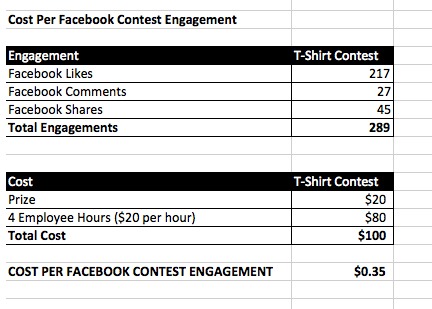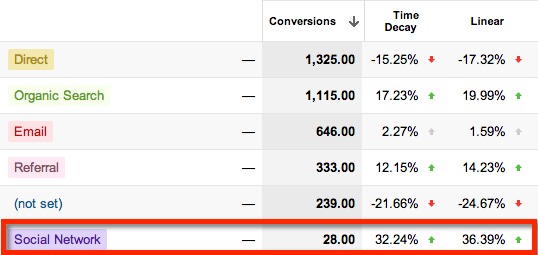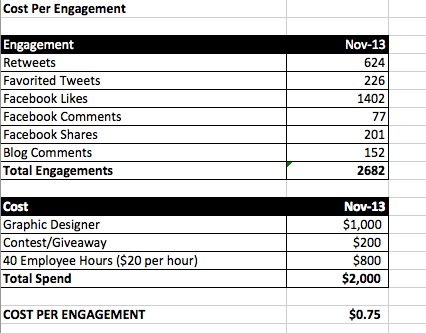No more excuses.
It’s time that we justify the time, energy and money spent on social media in the same way we justify all of our other business activities.
But it isn’t easy. In one case — it’s very difficult. In another, it’s actually very simple.
We’ll talk about both and, in the end, you’ll have a framework for measuring the impact social engagement is having on your business.
Measure what matters
At the end of the day, only two things matter to the success of your business:
- Revenue
- Costs
Don’t believe me?
Open your accounting software and show me where Facebook Likes appear on your Profit and Loss statement. Show me Retweets on your Balance Sheet.
Your accountant, the IRS and the bank don’t care how many Retweets you are getting. Businesses succeed or fail based on how much money comes in the door and how much goes out.
That doesn’t mean that Retweets don’t lead to sales. It doesn’t mean that discussions on your Facebook page aren’t a cost effective way to communicate with your market. They might very well be.
What it does mean is that simply measuring the number of Facebook Fans, Twitter followers or Retweets you are getting isn’t ideal.
But it is possible to start measuring social media’s impact on your business. You just need to know where to concentrate your effort.
Let’s start with the bad news…
Measuring revenue from social engagement is hard
In some cases, it’s impossible. But don’t let that deter you. You can get close enough if you understand the problem.
The problem can be summed up to a single word that makes marketing analytics professionals shudder: attribution.
Sales attribution is defined as the identification of the actions a buyer took that contributed to a sale and assigning a value to those activities.

The attribution problem isn’t new. Marketers have always struggled to pin a sale to any particular marketing tactic. You’ve likely heard the quote from 19th century business man, John Wanamaker:
“Half the money I spend on advertising is wasted; the trouble is I don’t know which half.”
Attribution is still a major issue in digital marketing, particularly when we try to measure the impact of social engagement.
Sure, we have access to tools like Google Analytics where we can track sales and see the source of traffic, but even the most expensive analytics tools struggle with attribution.
Don’t use this model…
Most analytics tools give 100% credit (attribution) to the last click.
For example, let’s say that a prospect…
- Searches Google for ‘digital camera bags’ and lands on your website. They browse your camera bags, Like your Facebook page and then leave your website.
- Two days later, the same prospect sees an article from your company on Facebook that compares popular camera bags. They click on the link, visit your website, read the article and then leave your website.
- One week later, the same prospect searches Google for ‘buy digital camera bag’ and sees a Google AdWords ad from your company. They recognize your brand from prior interactions, click on the ad and buy a camera bag.
The order of interaction with your website looks like this ORGANIC SEARCH > SOCIAL NETWORK > PAID SEARCH.
In most analytics tools, including Google Analytics, the default attribution (or credit) for the sale will look like this,
The initial Google search and the interaction on Facebook would get zero credit while your Google AdWords program will get full credit.
This might lead you to believe that your time/money spent on SEO and on Facebook are useless.
This model is called Last Click Attribution. The last interaction gets all the credit and it’s a terribly misleading way to measure your marketing.
There is a better way
It’s not perfect, and won’t likely ever be, but there are better ways to deal with the attribution problem.
There are other attribution models available — even in the free version of Google Analytics. You just need to know where to look.
First, you will need to have goals set up in Google Analytics. If you don’t, read this support document from Google to get Goals set up.
Open Google Analytics and then click on CONVERSIONS > ATTRIBUTION > MODEL COMPARISON TOOL. You’ll then see a number of attribution models to choose from.
You can change the way that Google Analytics is attributing credit to Goal Conversions.
Here’s a description of each of the available attribution models in Google Analytics,
- Last Interaction – The last click gets 100% attribution
- Last Non-Direct Click – The last click (excluding Direct visits) gets 100% credit
- Last AdWords Click – The last click from an AdWords ad gets 100% credit
- First Interaction – The first visit within the Lookback Window (up to 90 days prior) gets 100% credit.
- Linear – Each visit within the Lookback Window gets equal credit.
- Time Decay – More recent visits within the Lookback Window get more credit while older visits within the Lookback Window get less credit.
- Position Based – The First and Last visits within the Lookback Window split attribution.
In our example we sold a digital camera bag to a prospect that visited via Organic Search (SEO), Facebook (Social) and then ultimately converted after visiting through a Google AdWords Ad.
There are only two models above that would give a shred of credit to your social media engagement — Linear and Time Decay.
In fact, these are the two models (Linear and Time Decay) you should be using if you want a true understanding of how your different marketing channels, including social media, are performing.
Google Analytics allows you to compare up to three models side by side. Below is a comparison of the Last Interaction Model to the Time Decay and Linear models for a start-up software company.
As you can see, when you look at Time Decay and Linear Models, it becomes clear that Social Network’s have contributed up to 36.39% more to goal conversions than we would have thought viewing only the Last Interaction model.
For this company, engaging in social media is clearly better at “assisting” in conversions than it is at being the last touch before a conversion.
By understanding attribution modeling you will get a clearer picture of how social engagement is affecting the first of the two critical measurements in your business: revenue.
Is it perfect? No. Is it better than looking at Last Click Attribution only? You betcha.
Now, it’s time for the good news.
Measuring the cost of social media engagement is easy
Measuring revenue isn’t easy. I get it. But the other critical measurement in your business is well within your reach: cost.
How much are you spending on social engagement? We need that number.
Are you paying graphic designers to build awesome graphics for Facebook? Are you buying prizes for contests and giveaways? Are you paying an employee, agency or contractor to engage in social media?
If it’s just you tweeting and Facebooking (is that a word?) you are still spending money. What value do you place on your time? $50 per hour? $100? $200?
Multiply that amount by the number of hours you spend engaging on social media, that’s your cost. For example, If you spend 20 hours on social media sites per month and you value your time at $100 per hour, your budget is $2000 per month.
Now, at the very least, calculate a measurement called Cost per Engagement over a particular period of time. You do this by adding all social media engagements together and dividing your spend by that number.
Your spreadsheet might look like this,
$2000 spend / 2682 engagements = $0.75 Cost Per Engagement
It’s not easy to add up all of your retweets, Likes, shares, etc. It’s a manual process.
As a result, this might be a calculation you make once a quarter or twice per year. That said, it might be exactly what you or your boss needs to see. In that case, it’s worth taking the time to calculate this metric on a regular basis.
The next step is to compare across channels, time periods and tactics. Based on what you’ve gathered, you can see how you can easily get to metrics like,
- Cost per Twitter engagement
- % Increase In Social Engagement (Month over Month)
- Cost per Facebook Contest Engagement
The latter might look like this for a T-shirt contest,

Hmmm… this contest cost only 35 cents per engagement while the overall Cost Per Engagement from social media is 75 cents. Maybe we should run more contests.
When you start comparing across channels, time periods and tactics you will be able to make informed business decisions like,
- Should I pay an agency $2000 per month to manage our Twitter account?
- Did adding the graphic designer in November improve our social media engagement?
- Should I run more contests on our Facebook page?
And that’s what it’s all about folks. We measure so that we can make decisions that affect our revenue and costs.
Your turn. What questions do you have about measuring social media engagement? What advice do you have for us? Let us know in the comments section below.





